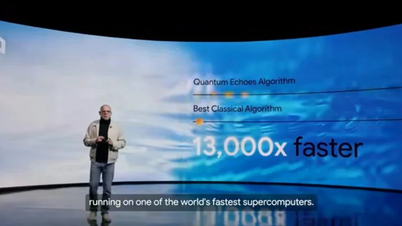Veo 3 is Google’s most advanced video -generating AI model to date. Using this tool, users can turn prompts into realistic, indistinguishable videos, complete with dialogue and background music. Here’s what you need to know about the hottest video-generating AI tool today.
A new kind of video-generating AI
While AI video generation isn’t a new idea, Veo 3 differentiates itself from competitors like OpenAI Sora and Adobe Firely by being able to create audio and video at the same time. That means you can describe a scene and Veo 3 will generate a corresponding video, including dialogue and background music. The results are also impressive, as many viewers have no idea whether the video they’re watching is real or fake.
According to TechRound , the four outstanding advantages of Veo 3 include: creating audio and video with a single prompt; natural motion; high-resolution video, for both personal and professional purposes; adjusting camera angles, building landscapes and maintaining consistent characters in videos.
Video created entirely by Google Veo 3. Source: Google
Veo 3 is one of Google's most exciting products, but it doesn't exist in isolation. In fact, it's designed to work with other AI tools, including: Gemini (a language model that allows Veo 3 to understand and convert text into video); Imagen 4 (which creates visual images for Veo 3 to reference); and Flow (a video creation platform that helps people use Veo 3 to create complete stories).
When was Veo 3 released and how much did it cost?
At the I/O 2025 conference on May 20, Google announced Veo 3 along with other AI tools. Users in 73 countries (not including Vietnam) can use Veo 3 when signing up for the AI Ultra package for $249.99/month. Google is offering a 50% discount for the first three months, down to $124.99/month. Users are given 12,500 credits per month, each Veo 3 video creation costs about 150 credits.
In a press conference, Demis Hassabis - CEO of Google DeepMind, the developer of Veo 3 - said that with Veo 3, the era of "silent video creation" is over.
DeepMind doesn’t mention the source of the Veo 3’s training data, but YouTube is likely an option. Google owns YouTube, the world’s largest video repository. To mitigate the risk of deepfakes, DeepMind uses proprietary watermarking technology called SynthID to embed invisible markers into the frames generated by Veo 3.
While companies like Google tout Veo 3 as a powerful creative tool, many artists are concerned that it threatens to disrupt entire industries. A 2024 study by the Animation Guild, which represents Hollywood animators and filmmakers, estimated that more than 100,000 film, television, and animation jobs in the US will be disrupted by AI by 2026.
Veo 3 is currently available to Google AI Ultra and AI Pro users (first month free trial, $20/month thereafter). Google AI Pro subscribers in 73 countries can access Veo 3 in Flow and create 10 test videos in the Gemini app. After a month of testing, you may have an answer to whether or not it’s worth shelling out hundreds of dollars for Veo 3.
(Synthetic)
Source: https://vietnamnet.vn/moi-dieu-can-biet-ve-veo-3-cong-cu-ai-tao-video-gay-sot-hien-nay-2407162.html







![[Photo] Opening of the 14th Conference of the 13th Party Central Committee](https://vphoto.vietnam.vn/thumb/1200x675/vietnam/resource/IMAGE/2025/11/05/1762310995216_a5-bnd-5742-5255-jpg.webp)



























![[Photo] Panorama of the Patriotic Emulation Congress of Nhan Dan Newspaper for the period 2025-2030](https://vphoto.vietnam.vn/thumb/1200x675/vietnam/resource/IMAGE/2025/11/04/1762252775462_ndo_br_dhthiduayeuncbaond-6125-jpg.webp)







































































Comment (0)